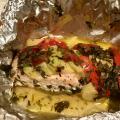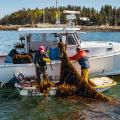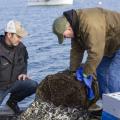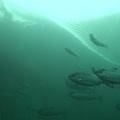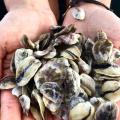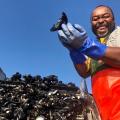Salmon, mussels, oysters, and kelp - we're just getting started. These recipes will take your taste buds on a savory adventure along the Maine coast.
Roasted Maine Salmon Packets
This recipe makes just one serving. Of course, it is infinitely expandable—for 2, 4, 6, or many more.
Ingredients for each packet:
1/2 medium potato, diced
1 tablespoon extra-virgin olive oil
One portion of Maine farmed salmon, weighing about 5 ounces
1 scallion, green and white parts, sliced diagonally in half-inch slices
1 thick slice of fresh ripe tomato, diced
3 or 4 long thin strips of red or yellow sweet pepper
About a tablespoon minced fresh herbs (flat-leaf parsley, basil, tarragon, chervil, cilantro—whatever you have available)
1 teaspoon fresh lemon juice
Salt and freshly ground black pepper to taste
Bring a small pot of water to a boil and toss in the potato dice. Boil for 4 or 5 minutes, until just tender, then drain immediately.
Pull out a square of heavy-duty aluminum foil large enough to make a loose packet around the fish and the vegetables. Smear about half the oil on the foil sheet and set the fish in the middle.
Pile the diced potato, scallions, tomato dice, and pepper strips on the fish. Sprinkle with the herbs, remaining oil, and lemon juice, adding salt and pepper. Pull up the sides of the foil and seal to make a loose but tightly sealed packet.
You can do all of this well ahead of time and refrigerate until you’re ready to cook but it’s a good idea to allow time to bring the packets back to room temperature before cooking.
Heat the oven to 425 degrees. Set the packets on a cookie sheet and transfer to the hot oven. Roast for about 15 minutes, or until fish and vegetables are cooked all the way through. Serve immediately in the packets, breaking each one open at the table to release the remarkable fragrance.
Note: This can be varied in many ways. For a more Mexican flavor, add slivers of jalapeno pepper, minced cilantro, and lime juice. For a more Mediterranean presentation, add chopped garlic, some pitted black olives, and capers. For an Asian-style dish, add minced fresh ginger, chopped cilantro, and, if available, slivered lemon grass, and substitute soy sauce for the lemon juice.
Oven-Braised Maine-Farmed Trout
Roast whole trout, split and gutted, in the same way as the salmon packets above. Oil a sheet of aluminum foil large enough to enclose the trout, then place thin slices of lemon, coarsely chopped herbs (dill is delicious but so is fresh thyme, rosemary, or flat-leaf parsley), sea salt, and freshly ground pepper in the belly opening. Seal up the packet in a loose sort of purse and roast in a 425 degree oven for 15 to 20 minutes. One trout per serving will do.
Baked Monkfish in a Kelp Wrapper
This is similar to the other fish packets except using fresh Maine kelp for the wrapper gives bland monkfish greater flavor and softens somewhat that fish’s chewy texture. The kelp, in this case, is wrapped firmly around the fish pieces, just like a Christmas present. This makes 4 servings.
12 ounces monkfish filet
1 or 2 large fresh Maine kelp “leaves,” stipes removed
Sea salt and freshly ground black pepper
1 tablespoon minced fresh basil, dill, or fresh thyme
1 tablespoon minced fresh flat-leaf parsley
4 very thin slices whole lemon (skin and flesh together)
About ¼ cup extra-virgin olive oil
About ¼ cup plain tomato sauce or crushed whole canned tomatoes
Cut the monkfish filet into 4 equal serving pieces. Pat dry with paper towels and set aside.
Bring a large pot of water to a rolling boil. Have ready a big bowl of iced water. When the water is boiling, drop in the kelp leaves, stirring to make sure they are completely immersed. Blanch the leaves for 15 to 20 minutes or until they turn from reddish brown to bright green. As soon as they do, remove from the boiling water and plunge into the ice water.
When the kelp leaves are cool enough to handle, spread one out on a counter top and cut a square piece large enough to wrap one of the fish pieces. Set the fish piece in the middle of the kelp square and sprinkle with salt, pepper, and minced herbs. Top with a thin slice of lemon and about a teaspoon of olive oil, then wrap the kelp square up and around the piece of fish. Repeat for all the fish pieces.
Set the oven to 350 degrees.
Add a tablespoon of oil to the bottom of an oval gratin dish just large enough to hold all the fish packets. Add the tomato sauce and mix with the oil, then arrange the kelp-wrapped fish on top of the sauce. Spoon any remaining olive oil over the top of the packets and transfer the dish to the oven. Bake for about 20 minutes, or until the fish is thoroughly cooked. Remove and serve immediately, with more lemons to squeeze over if you wish.
Note: You might be tempted to remove the kelp wrapper, but don’t! It is tender and delicious and adds immeasurably to the flavors of the dish.
Maine Mussels, Spanish Style
This will serve 2 or 3 people as a main course, but if served as a starter it should be enough for 6.
1/2 cup extra-virgin olive oil
1 large leek, trimmed and chopped
½ fennel bulb, if available, trimmed and chopped
2 or 3 ripe plum tomatoes, peeled and chopped
3 cloves garlic
1 pinch saffron threads
¼ to ½ cup dry white wine
1 teaspoon Spanish smoked pimenton, sweet or hot
3 pounds cleaned Maine farmed mussels in the shells
Salt and freshly ground black pepper
Heat the oil in a large Dutch oven or heavy saucepan. Add the leek, fennel, tomatoes, and garlic, and cook over medium-low heat for about 10 minutes or until the vegetables are soft.
While the vegetables are cooking, mix the saffron with a couple of tablespoons of water, crumbling the threads. Add to the vegetables, along with the wine. Stir in the pimenton, then tip in the cleaned mussels and cook, stirring occasionally to bring up the ones on the bottom, until all of the mussels have opened. As they open, extract them and set aside in a deep plate or bowl. If after about 15 minutes there are still a few mussels that stubbornly refuse to open, discard them. Add the already opened mussels back to the liquid and stir to mix everything together well. Serve immediately, with plenty of bread to sop up the sauce.
Maine-Farmed Oyster Stew
You would be hard put to improve on Maine oysters, simply opened and served on the half-shell with a little mignonette of good wine vinegar with finely minced shallots (although my personal preference is for a wee dab of horseradish and nothing else). Still, when you’ve tired of raw oysters, this is a wonderfully rich oyster stew. How many Maine oysters in a pint of shucked? Two dozen or a little more. If you shuck them yourself, be sure to save all the savory liquid.
Makes 4 servings.
1 pint shucked oysters with their liquid
¼ cup unsalted butter
1 garlic clove, minced
1 or 2 fat shallots, peeled and minced
4 cups whole milk
2 cups heavy cream
Dash of hot sauce (sriracha, Tabasco, or your choice)
Sea salt and freshly ground black pepper
Ground paprika, Spanish pimenton or French piment d’Espelette
Strain the oysters from their liquid, setting the liquid aside.
Melt the butter over medium-low heat in a heavy saucepan. Add the garlic and shallots and cook gently, stirring, until the vegetables are softened, then stir in the oyster liquid, the milk, and the cream. Bring to a simmer and cook together for about 5 minutes to slightly thicken the mixture and get rid of the raw flavors. Stir in the hot sauce and plenty of black pepper.
Now, with the heat turned down very low, add the oysters to the stew and cook briefly, just until the edges start to curl. Over-cooking will toughen the oysters—not good. Taste the stew and add salt if necessary.
Serve immediately, adding a dollop of butter on top of each bowl-full, along with a sprinkling of ground red pepper.
Oyster crackers are traditional although not at all necessary. Good crusty bread will be fine in their place.








